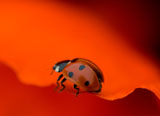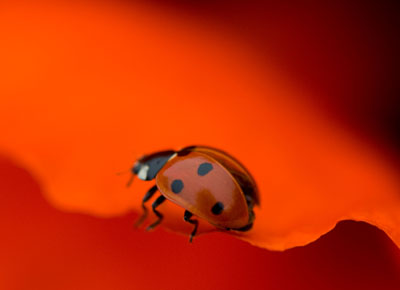The secret life of ladybirds
Probably Britain's most loved insect, the ladybird is wildly promiscuous-females can mate up to 20 times a year-and a keen carnivore, reports David Profumo


Bombardier, deathwatch, stag, hermit, sexton-the Almighty seems to have had a penchant for creating beetles, but they are not widely beloved. One striking exception is the clownish-looking ladybird, surely Britain's most popular insect. Its convex, brightly coloured appearance is almost too familiar to need description.
‘They are easily spotted,' quips coleopteran pundit Mike Majerus, but, in fact, among the UK's 42 resident species of Coccinellidae, there is notable diversity. Their family name means ‘clad in scarlet', but the background colour to their elytra (hard forewings) includes yellow and black, some are striated and others have no spots at all. Our most common are the seven-spot (septempunctata) and two-spot, the greatest number being 24; such patterns have nothing to do with their age.
The larch variety is all brown and there are also melanic specimens. Non-entomologists often confuse certain carpet beetles and froghoppers with true ladybirds. That burnished livery is aposematic- a warning scheme to deter would-be predators, primarily spiders and birds. When alarmed, the ladybird resorts to ‘reflex bleeding': it exudes an acrid, yellowish liquid from its leg joints, which is smelly and unpalatable. The overall coloration is occasionally cryptic in function, as with the cream-streaked variety, which camouflages itself among the buds of pine trees. The ladybird's chief enemy is a type of wasp that parasitically injects its eggs through the beetle's exoskeleton.

One of the earliest insects to emerge from its winter dormancy, the ladybird reappears around March, if the season is mild, and begins to feed preparatory to mating. It is wildly promiscuous. The two-spot female can mate 20 times a year and, with copulation lasting up to nine hours, its love life is practically tantric. Come May, little batches of pale eggs are laid in the vicinity of food supplies such as aphid colonies and, when the blackish larvae hatch, they grub around on handy greenflies for a month before becoming spotted chrysalises.
The adult imago is particularly abundant in hot weather, when mass migrations can occur. In August 1976, Majerus recorded hundreds of miles of the English coastline clogged with mostly seven-spots, comprising each day, ‘more than double the number of humans that now live, and have ever lived, on Earth'. Phew! When starving in such profusion, they may speculatively bite people with their strong mandibles. In 1835, the firemen of Reading were summoned to disperse huge coccinellid swarms with jets of tobacco-poisoned water.
Although a few are vegetarians, most ladybirds are carnivores and possess keen, aphidophagous appetites: every day, each can wolf down a dozen or so of these little sap-suckers, making them welcome to gardeners, orchard men and hop-growers especially. They have been widely introduced as biological pest-controllers, most
Elsewhere in America, the convergent variety is seasonally harvested with vacuum cleaners and sold on to farmers in bulk (there are roughly 1,500 to the ounce): the recommended rate of release is 60,000 ladybugs per acre of fruit trees.
Sign up for the Country Life Newsletter
Exquisite houses, the beauty of Nature, and how to get the most from your life, straight to your inbox.
Almost universally depicted as userfriendly, the ladybird has featured as the colophon of a famous book imprint and the brand name for a Woolworths range of children's clothing. Versions of the nursery rhyme doggerel that urges the beetle to fly back to its burning home exist across Europe: the French have her nest being destroyed by sword-wielding Turks, whereas the Turks themselves nickname the creature the ‘good-luck bug'. So widespread is the charm that it must be the vestige of something more portentous.
Some believe it is a relic of exorcism, a reminder of the dangers that lurk after sunset or possibly just a warning that the hop fields will be torched after harvest. The ladybird was popularly a love oracle, too: ‘Bishy, Bishy Barnabee/Tell me when my wedding be,' chanted the Norfolk lasses of yesteryear. Bishop Barnaby (who hailed from the Fens and was supposedly burned at the stake) is just one among our plethora of vernacular names-cush-cow lady, fly-golding, Marygold -and folklorists have identified many religious overtones.
There is a powerful association with the Blessed Virgin Mary (in Germany, it is the Marienkäfer), because of her traditional red cloak embroidered with the seven joys and sorrows. There is even conceivably a link with fertility cults going back to the Sun God, the orange groves of the Mediterranean and the Ancient Egyptian creation myths concerning the scarab- D. H. Lawrence certainly thought so and his long story The Ladybird is a poignant love-triangle shaded with such dark deities. Did our children's rhyme originally allude to the flames of purgatory? That was not clear from Woolies' advertisements. But humans and ladybirds do still get on like a house on fire.
* Subscribe to Country Life and save
* Follow Country Life magazine on Twitter
Country Life is unlike any other magazine: the only glossy weekly on the newsstand and the only magazine that has been guest-edited by HRH The King not once, but twice. It is a celebration of modern rural life and all its diverse joys and pleasures — that was first published in Queen Victoria's Diamond Jubilee year. Our eclectic mixture of witty and informative content — from the most up-to-date property news and commentary and a coveted glimpse inside some of the UK's best houses and gardens, to gardening, the arts and interior design, written by experts in their field — still cannot be found in print or online, anywhere else.
-
 380 acres and 90 bedrooms on the £25m private island being sold by one of Britain's top music producers
380 acres and 90 bedrooms on the £25m private island being sold by one of Britain's top music producersStormzy, Rihanna and the Rolling Stones are just a part of the story at Osea Island, a dot on the map in the seas off Essex.
By Lotte Brundle
-
 'A delicious chance to step back in time and bask in the best of Britain': An insider's guide to The Season
'A delicious chance to step back in time and bask in the best of Britain': An insider's guide to The SeasonHere's how to navigate this summer's top events in style, from those who know best.
By Madeleine Silver